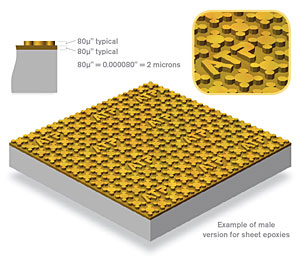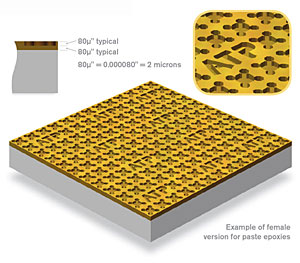|
“Fractal Fasten” is a unique backside metallization developed to enhance the adherence of substrates to carriers using both paste and sheet epoxies. This unique metallization was designed with a “fractal” pattern that was perfected in cooperation with manufacturers using a variety of substrate materials, mounting configurations and carrier materials. The result is an unprecedented backside metallization that has superior adhesion, pull and shear strengths that cannot be achieved with standard metallization schemes. This metallization technique offers a surface that allows the epoxy to attach itself securely and grip firmly, therefore eliminating possible delaminating and dislodging issues. This method of attachment has proven to be effective with substrates attached to carriers or mounted directly onto kovar, aluminum and other various metal housings. ATP has spent numerous hours of electrical design simulations to ensure that the metallization does not have any adverse electrical skinning or negative ground effects on conventional microwave designs.
Fractal Fasten
ATP now offers this same unique cost effective backside metal to all of our customers wishing to attach substrates with epoxies without experiencing the usual problems, such as substrates not adhering or lifting during or after temperature shock and temperature cycling. This metallization scheme, when used and applied as directed, will result in superior adhesions in comparison to conventional-type processes, thus eliminating the age old headaches of pre-scoring or roughing up the surface of the substrate before attaching.
ATP has developed two types of backside metallization to optimize adhesion, utilizing both paste and film epoxy applications, allowing our customers to attach directly to aluminum, copper, brass and kovar housings to minimize size and weight of the assembly. Contact ATP for further information on this unique backside metal or to request samples. We are very interested in discussing your individual application process and product needs.
|
|
Example of Backside Metallizations

ATP1019 Sample
Film Epoxies
Recommended: Ablefilm 5025E
Prepare and cut a predetermined suitable size of Ablefilm 5025E to give ample coverage to the substrate to be attached. Precautions should be taken with this material since it is usually stored frozen and needs to reach room temperature before handling. Clean all surfaces to be joined with Isopropanol. Place the Ablefilm 5025E in between the housing/carrier and the male “Fractal Fasten” substrate to be attached in a sandwich fashion. Repeat this until all substrates have been positioned in the chain as desired. Special tooling will be required to apply even pressure to the entire assembly during the thermal compression curing cycle. The tooling can be comprised of a dead weight fixture that covers the entire assembly or it can be a series of mechanical or spring clamps to apply ample pressure to the assembly during the curing process. A neoprene, Teflon or heat-resistant silicone rubber should be used to protect and distribute the weight evenly in between the fixture and the substrate. Apply a minimum of 6 psi of pressure evenly across the entire assembly in a curing oven or hot plate while elevating the temperature of the assembly to 125°C for 120 minutes or 150°C for 30 minutes (refer to Ablefilm 5025E application notes for best results). If spring clamps are used, be aware that over time and temperature exposure, the tension of the springs can change and may need to be recalibrated for accurate pressure on the substrate assembly. Although higher pressures may be applied for optimum bonding strength, one must use caution based on thickness of substrate to eliminate breakage potential. Extreme pressures have been known to displace the polymers in the epoxy and have adverse effects. Individual experimentation will be required for optimum performance and adhesion depending on size and thickness of substrates.
|
|
Example of Backside Metallizations

ATP1018 Sample
Paste Epoxies
Recommended: For all conductive paste expoxies
Apply liberal amounts of 84-1 paste epoxy to a plastic or rubber squeegee of proportionate size to the substrate that will be attached. Squeegee the epoxy onto the back surface of the female “Fractal Fasten” substrate with even pressure, forcing the epoxy into the fractal cavities until even and full coverage is achieved, making sure all cavities have been filled. Use Isopropanol to clean and remove excess epoxy on the sides of the substrates to mitigate any potential shorting from the bottom to top side. Immediately apply epoxy to the surface of the housing or carrier you wish to attach the substrate to, making sure you have ample coverage for good fill, but not too much, so that you will not have excessive epoxy that may cause shorting from bottom to top sides. Apply moderate pressure with a slight scrub to allow the two epoxies to meld together and sit flush on the attached surface. Inspect carefully for any shorting of epoxy. Repeat these steps as necessary until substrate chain is complete. Cure the epoxy per the manufacturer’s recommendations. This and additional information can be found on the application notes from the epoxy manufacturer or on their website.
Disclaimer: The results are based on our individual experiments to achieve optimum die shear strength. Results may vary or adjustments may be needed to achieve optimum results for individual applications. Proper cleaning must be done to each surface to achieve maximum bonding strength. Please refer to the application notes of the epoxy manufacturer.
|
|
The following information is provided by Ablestik and can be found on their application notes or website when purchasing their products.
Ablefilm 5025E is used for bonding all types of circuit board materials to metal backplanes and heat sinks. High frequency fluoropolymer and ceramic circuits bonded to copper, brass, Kovar and aluminum are typically application substrates. In most cases, these metals are typically protected with a gold plate finish. The high electrical and thermal conductivity of 5025E ensures a reliable RF ground plane. High manufacturing yields require excellent electrical continuity and mechanical performance. 5025E offers void free electrical continuity and uniform bond line adhesion.
5025E has a work life of three months at room temperature. Useful life can be extended with refrigeration.
|
|
Once the film adhesive is removed from frozen or cold temperature storage, the product is ready to use when it has reached ambient room temperature. While cleaning of substrates is not mandatory, an organic solvent (i.e. Isopropanol) wipe is recommended to remove any oils that might interfere with the bonding process or electrical interface.
Films need applied pressure during cure to promote proper wetting of substrate surfaces. Common industry practices include the use of spring clamps, lamination presses, dead weights and vacuum bagging. The technique to apply pressure will vary by application and customer preference. However, the recommended cure pressure for 5025E is between 5 to 60 psi. For large surface area applications, a rubberized silicone pad is recommended between one of the pressure plates and the bonding part in order to equalize the applied pressure over the entire area.
|
|
After fixturing, the parts are then cured at an elevated temperature. The specified temperatures and times refer to the bondline values. It should be noted that large mass assemblies will take longer time to achieve bondline temperature.
Storage and Handling
The storage life of 5025E is 6 months at 5°C. For best results, store in original, tightly covered containers in clean, dry areas. Usable shelf life may vary depending on method of application and storage conditions. 5025E becomes brittle below -5°C. If material goes below this temperature, it should be handled gently and entire package should be warmed to room temperature before opening. This will eliminate the possibility of breaking it in the brittle state or allowing condensation to collect on the product.
|